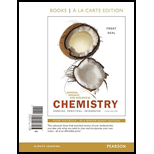
Concept explainers
To identify:
Whether NAD+ is oxidized or reduced form.
Introduction:
The aerobic
To identify:
Whether FADH2 is oxidized or reduced form.
Introduction:
The aerobic cellular respiration is the process through which the food is broken down by cells in the body to provide energy. There are three steps in aerobic cellular respiration, namely- glycolysis, citric acid cycle, and electron transport chain.
To identify:
Whether QH2 is oxidized or reduced form.
Introduction:
The aerobic cellular respiration is the process through which the food is broken down by cells in the body to provide energy. There are three steps in aerobic cellular respiration, namely- glycolysis, citric acid cycle, and electron transport chain.
Want to see the full answer?
Check out a sample textbook solution
Chapter 12 Solutions
General, Organic, and Biological Chemistry, Books a la Carte Edition (3rd Edition)
- Which nutrient provides energy in its most concentrated form?arrow_forwardCan a chemical that, in essence, goes through the body unchanged be an essential nutrient? Explain.arrow_forward1.In the mitochondria, enzymes attached to the membrane use the ______________ to produce a ____________ difference and thus an electrical potential. Making the transfer of _______________ possible a. pH, flow of electrons, hydrogens b. pH, electron flow, oxygen c. electron flow, pH, hydrogens d. Electron flow, pH, Oxygen 2.Which of the following sugars can be a substrate for hexokinase? a.glucose b.fructose c.mannose d.all these e.none of thosearrow_forward
- Is it possible to get a sufficient supply of nutritionally adequate proteins by eating only vegetables?arrow_forwardNAD+ and FAD+ are?arrow_forwardAll are metabolic pathways for glucose catabolism (metabolism) EXCEPT: Question 70 options: A) Embden-Myerhof pathway B) Glycogenesis C) Glyconeogenesis D) Hexose monophosphate shuntarrow_forward
- WHAT WAS THE UREASE TEST ORIGINALLY DESIGNED FOR? WHAT ORGANISM IS USED TI DEMONSTRATE A UREASE POSITIVE TEST? WHAT IS THE INDICATOR IN THE UREASE TEST AND WHY WAS IT USED? WHAT IS THE COLOR OF A POSITIVE TEST AND WHY IS IT THAR COLOR? WHAT DOES A ORANGE-YELLOW COLOR AT THE END OF 24 HOURS REPRESENT? IF THIS SAME TUBE PRODUCED A PINK COLOR WHEN LEFT IN THE INCUBATOR FOR AN ADDITIONAL SIX DAYS WHAT WOULD THIS COLOR CHANGE INDICATE?. WHAT IS THE pH IN A NEGATIVE UREASE TEST?arrow_forwardHow is energy transferred to foods when they are deep fried in fat?arrow_forward
 Introduction to General, Organic and BiochemistryChemistryISBN:9781285869759Author:Frederick A. Bettelheim, William H. Brown, Mary K. Campbell, Shawn O. Farrell, Omar TorresPublisher:Cengage Learning
Introduction to General, Organic and BiochemistryChemistryISBN:9781285869759Author:Frederick A. Bettelheim, William H. Brown, Mary K. Campbell, Shawn O. Farrell, Omar TorresPublisher:Cengage Learning Chemistry for Today: General, Organic, and Bioche...ChemistryISBN:9781305960060Author:Spencer L. Seager, Michael R. Slabaugh, Maren S. HansenPublisher:Cengage Learning
Chemistry for Today: General, Organic, and Bioche...ChemistryISBN:9781305960060Author:Spencer L. Seager, Michael R. Slabaugh, Maren S. HansenPublisher:Cengage Learning Chemistry In FocusChemistryISBN:9781305084476Author:Tro, Nivaldo J., Neu, Don.Publisher:Cengage Learning
Chemistry In FocusChemistryISBN:9781305084476Author:Tro, Nivaldo J., Neu, Don.Publisher:Cengage Learning General, Organic, and Biological ChemistryChemistryISBN:9781285853918Author:H. Stephen StokerPublisher:Cengage Learning
General, Organic, and Biological ChemistryChemistryISBN:9781285853918Author:H. Stephen StokerPublisher:Cengage Learning Organic And Biological ChemistryChemistryISBN:9781305081079Author:STOKER, H. Stephen (howard Stephen)Publisher:Cengage Learning,
Organic And Biological ChemistryChemistryISBN:9781305081079Author:STOKER, H. Stephen (howard Stephen)Publisher:Cengage Learning,





